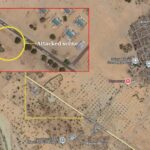
On Saturday, Dec. 21, residents of the Dalori community were enjoying a peaceful evening, with children fast asleep and the night offering the perfect atmosphere for rest. Suddenly, this peace and tranquillity were disrupted by the intrusion of members of the Islamic State West African Province (ISWAP).
Around midnight, the terrorists attacked the village which shelters displaced communities housed in the 1000 Housing Unit along the Maiduguri-Konduga road in Borno state, northeastern Nigeria. It started with gunfire.
The attack was directed at a security post that provides protection and safety to the community.
Two vigilantes stationed in a patrol vehicle were caught unprepared as they dozed off during their midnight watch. One of the vigilantes died and another was injured by a gunshot on the leg. The injured man was later transported to a hospital in Maiduguri for urgent medical care.
The attack led to the burning of two vehicles, and they escaped with a functional patrol pickup truck.
For the residents, the night was a haunting reminder of their vulnerability. Abubakar Mohammed, a father of four, recounted the harrowing experience. “I directed my family not to panic. I held my youngest child close while my wife covered our other three children with a blanket. The sporadic gunfire was terrifying, but I knew we had to remain calm.”
Mohammed and his family resettled in the housing unit only ten months ago and had begun to rebuild their lives after fleeing the horrors of Boko Haram’s earlier attacks in their hometown several years ago. Saturday’s event brought back painful memories. “It reminded me of the nightmare from eight years ago when they attacked my village. But hope consoled me. I reminded myself that we have survived this before.”
The attack, according to residents interviewed by HumAngle, lasted approximately 30 minutes. By morning, the community’s normal life resumed. The air was filled with the sounds of daily life, but the charred remains of vehicles and incinerated trees remained.
Residents spoke of the psychological impact left behind by the attack. “Even though the gunfire stopped and they left, I couldn’t sleep for the rest of the night. Every little sound made my heart race,” Adam Kachallari said.
Dalori and its neighbouring communities have been considered relatively peaceful in recent months, providing a fragile refuge for displaced families attempting to rebuild their lives. The attack, however, is a chilling reminder of the insurgency’s reach and the enduring challenges of maintaining security in these vulnerable areas.
For Mohammed and many others, the Saturday night attack was not just an isolated event but a reminder of uncertainty in a place they hoped would be a sanctuary for them and their families. “We want the government to provide us with security lights that would be powered by solar energy, this will reduce security threats that may come in the night like these,” Mohammed said.
Efforts were made to reach the state’s police command for an update, but it was unsuccessful.
On December 21, the Dalori community in northeastern Nigeria was disrupted by an attack from members of the Islamic State West African Province (ISWAP). The assault targeted a security post, resulting in one vigilante’s death and another’s injury, and led to the burning of two vehicles with the attackers escaping in a patrol truck.
Residents like Abubakar Mohammed, a displaced family settling after fleeing Boko Haram, faced traumatic reminders of past violence. The brief assault, which lasted about 30 minutes, left psychological scars on locals and highlighted vulnerabilities in these areas that had recently been considered relatively peaceful.
This attack underscored the challenges of maintaining security for families in these regions, with residents calling on the government for improved security measures like solar-powered lights to deter nighttime threats. Efforts to obtain an official statement from the state’s police command were unsuccessful.
